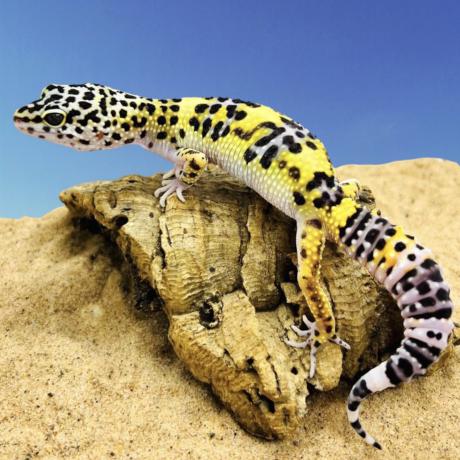

Arguably one of the most popular geckos in the hobby. Due to their ease of maintenance and affordable housing, we believe these geckos to be the best starter lizards for reptile enthusiasts.

A medium sized and thick-bodied gecko, with adults normally reaching sizes of around 20cm (8”) total length.
Leopard geckos are from the family group Eublepharidae and are easily distinguished from many other gecko species by their fully functional eyelids. Like many other crepuscular animals, if you look closely at their eyes, during the daytime they will have a slit type appearance, at night-time they dilate widely (much like a cat). These geckos are most active at dawn and dusk when temperatures are more favourable, and during the day they will mostly hide-away in burrows or caves.
Along with its stocky appearance, these geckos have a large and fat-tail containing enough fat reserve to helps geckos through annual periods of brumation. Secondly, the tail serves as a defensive mechanism and can be dropped if the gecko is attacked by a predator, allowing the gecko time to run for cover. It will regrow but is often shorter and stubbier in appearance.
Their skin is bumpy in appearance and the wild-type colouration is predominantly made up of colours of yellow, white, brown and black. Leopard geckos have two or three distinctive bands across their back along with an irregular spotted patterning. Selective captive breeding has also produced some well known morphs/mutations such as tremper albino, jungles, mack snow and murphy patternless.
Unlike many other gecko species, leopard geckos lack the ability to climb any surface and should be treated as terrestrial animals.
Sexing can be achieved once the animals reach a few months of age. Males typically get larger than females, develop a characteristic hemipenal bulge and femoral pores.
In the wild these lizards are found in the rocky arid grasslands and desert regions of Afghanistan, northwestern India, Pakistan and Iran.
Being terrestrial geckos (land dwelling), enclosures provided should be horizontal rather than vertical and with a minimum floor space of of 90cm x 40(36”x15") for a single adult. Wooden vivariums or terrainiums work best for housing leopard geckos due to their heat retaining property.
After many years of keeping and breeding leopard geckos, we advise housing these animals singular. It is possible to successfully house groups of females in larger enclosures and even male/female groups, but this will increase the chances of having problems with one or several of your geckos. Symptoms can include, stress and serious weight loss. Importantly, never attempt to house more than one male in the same enclosure or you risk serious injury and even death.
Hatchling and juvenile geckos can be housed in one of our smaller starter kits, which contain all of the necessary equipment, including UVB.
When setting up a vivarium for any reptile, you need to create a thermal gradient, commonly this is referred to as the ‘hot end’ and ‘cool end’ of the enclosure. Leopard geckos are ectothermic and rely on their surroundings to maintain their body temperature. Creating a clear thermal gradient allows the gecko to move to the most favourable area in the vivarium so they can warm and absorb energy.
The overall ambient temperature of the enclosure should be no lower than 24°C (75°F), with a basking (hot end) temperature of 29-32°C (85-90°F). An overall night-time temperature drop of around 5°C is advisable, this can be achieved easily using a good quality thermostat connected to a heat mat and/or a basking spot lamp.
There is much debate over the necessity of providing leopard geckos with any sort of UVB light. Recent studies have shown that their skin is twenty times more absorbent than that of a bearded dragon. With this in mind, we recommend providing a low level UVB light. After all, they are crepuscular and whilst limited, they would have some natural exposure to the sun in the wild. Providing a UVB light will also help stimulate natural daylight and will aid calcium and vitamin D3 absorption.
As leopard geckos are primarily from arid environments, a relatively dry enclosure must be provided. However, a damp area is required to aid geckos shedding its skin. Sphagnum moss in an enclosed cave works well, but you will need to spray the moss frequently with a hand sprayer to prevent it drying out.
Provide a suitably sized water bowl on the cool end of the enclosure for drinking.
For cage décor, provide reptile caves, cork oak branches or bark for them to climb over or hide under, combined with live or artificial plants. Ensure you fill out the enclosure well, to provide plenty of coverage and so that your gecko feels secure. Use a sand/soil based substrate to cover the floor of the enclosure.
Leopard geckos are insectivores. This makes feeding relatively simple as they eat an array of different live food. Favourites are mealworms, crickets, calci worms, locusts, dubia roaches and the very occasional waxworm. Baby or juvenile leopard geckos should be fed daily on 5-10 insects of suitable size, adults should be fed every other day on 3-5 insects.
Lastly and most importantly you must use a good quality dusting powder to provide essential calcium and vitamins to your leopard gecko. The traditional method of application is to use a spare live food tub or empty cereal container to coat the insects lightly in whichever dusting powder you are providing. We’d advise dusting your insects on every feed when your gecko is growing but to alternate between calcium and vitamin powders with the ratio of (2.1).